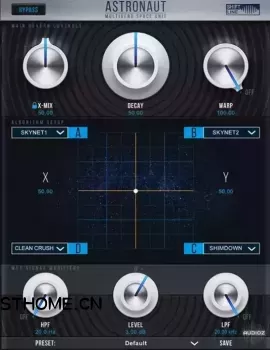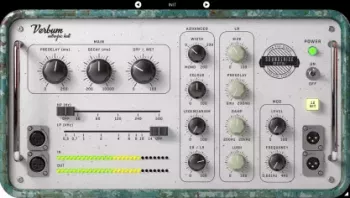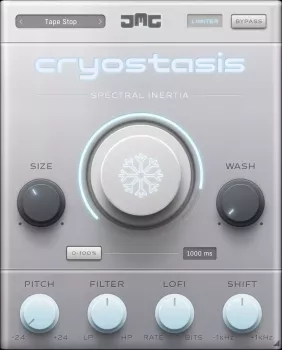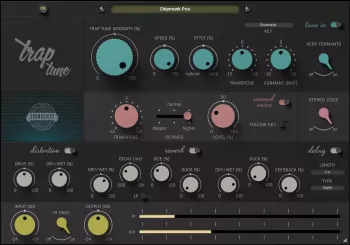16/01/2024 | x64 VST3 AU WiN MAC | 71 MB
英文简介:
The Astronaut Reverb is a VST3/AU plugin based on the reverb algorithms of the Astronaut pedal. The plugin is not just a digital copy of the pedal and has its own unique features. The algorithms it's based on have been optimized for better in-the-box performance and have a substantially different control scheme. The XY controller allows you to blend four different reverb algorithms simultaneously, making it a great tool for creating complex soundscapes. The plugin offers multiple blendable algorithms (9 reverb algorithms and 3 utility ones) along with the WARP knob, which simulates time speeding up or slowing down.
ALGORITHMS
The plugin offers 9 reverb algorithms and 3 utility ones:
CELL is a spaceship compartment with its size controlled by the DECAY knob. The size ranges from a small cell to a virtually endless void. Set the DECAY knob fully CW to "freeze" the signal and give it a very long decay time (over 10 minutes with WARP set to the max, even longer at any other WARP value).
ROD is a spaceship's outer shell, where the sound is recorded at different points. The DECAY knob controls the feedback of the signal hitting this "shell". The higher the DECAY value, the longer the decay time. The algorithm has a characterful resonant peak at around 1500Hz. Set the DECAY knob fully CW to turn the resonance into a signal generator with its frequency controlled via the WARP knob.
CAN is a metal cylinder with an uneven surface. The DECAY knob sets the size of the cylinder, which ranges from "soup can" through "barrel" all the way to "huge empty hangar". No signal freezing is available for this algorithm.
REVERDOX is a reverb/delay combo which plays the memory buffer contents forward and backward, resulting in a cool "time-floating" effect. The DECAY knob simultaneously controls reverb decay and feedback of the whole chain. Changing the DECAY value after the signal has been captured will result in artifacts typical of analog delays. Setting the DECAY knob to a very high value will result in gradually emerging self-oscillation. The algorithm forcibly stops the oscillation by reducing the DECAY value when no incoming signal is present.
SKYNET1 is a bright, futuristic space reverb algorithm. The huge soundscapes created with it can work great for slower atmospheric genres. Setting the DECAY knob to its max value will result in a decay time of several minutes.
SKYNET2 is a darker version of the previous algorithm. Just like SKYNET1, this one works great for ambient music. Heavier filtering is applied to the wet signal in this algorithm, resulting in shorter decay times.
SHIMUP1 is an octave-up shimmer reverb with moderate filtering and a distinctly bright character. Set the DECAY knob fully CW to "freeze" the signal and get a mid-heavy pad.
SHIMUP2 is another octave-up shimmer reverb, this time with less filtering and a different sonic character. This algorithm has a thicker, more massive sound than SHIMUP1. Setting the DECAY knob fully CW results in a signal freeze with a wider frequency range than in SHIMUP1. Affecting the frozen signal with the WARP knob will yield cool "space noises".
SHIMDOWN is an octave-down shimmer reverb which can add depth to any incoming signal — be it a pad, a lead, or anything else. Setting the DECAY knob fully CW doesn't freeze the signal but results in a very long and saturated reverb trail. Use the WARP knob to introduce more harmonics to the trail so that it can cut through the mix better.
CLEAN CRUSH is the incoming signal which is unaffected by reverberation. Use this utility algorithm if you only want to apply the WARP control or the filters to the incoming signal, which can result in peculiar Lo-Fi effects. Assign this algorithm to one of the points on the XY plane, blend it with up to three reverb algorithms at once, and sculpt a unique sound which goes beyond the capabilities of traditional samplers.
WHITE NOISE can be used the same way spices are in cooking. Set the WARP and filter knobs to just the right values to achieve cool distortion effects and ever-evolving chaotic soundscapes.
SILENCE is, well, silence. If you don't wish to use all four algorithm slots at once or want to create a tremolo effect on one of the axes, you can simply assign this algorithm to the desired slot in the XY controller. Once you've done that, the axis becomes a volume control for the algorithm on its other end.
SYSTEM REQUIREMENTS
Microsoft Windows
CPU: Intel Core i3-i9, AMD
RAM: 8 GB (recommended)
OS version: 7 — 11 (64-bit)
Minimum screen resolution: 1152 × 864
A DAW or any other software environment with VST3 support.
For proper plugin operation, please install the latest version of Microsoft C++ redist library.
Apple macOS
CPU: Intel Core i5–i9, Apple Silicon M1, M2
RAM: 8 GB (recommended)
OS version:: 10.13 — 14
Minimum screen resolution: 1152 × 864
A DAW or any other software environment with VST3/AU support.
ASTRONAUT FREE
This is a fully functional free version of the plugin.
Astronaut Free is also available as a standalone app (no DAW required). The paid version has no standalone app.
The Astronaut Free standalone app allows you to select the driver and has a Mono In checkbox, which selects the type of input signal (mono or stereo). Check the box if you're using a mono input signal.
Astronaut Free vs. Full Version:
Astronaut Free only has six algorithms from the full version: SKYNET1, SKYNET2, SHIMDOWN, CLEAN CRUSH, WHITE NOISE и SILENCE.
Astronaut Free has no internal preset system.
The installer for Astronaut Free contains the standalone app (AstronautFree.exe/AstronautFree.app).
官网: https://shift-line.com/astronautplugin







评论0